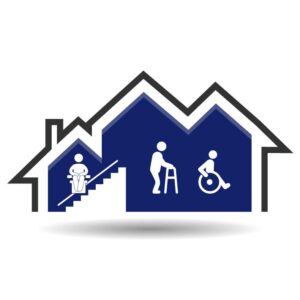Check Out These Resources For Persons With Disabilities From The Office of Texas Governor Greg Abbott
https://gov.texas.gov/organization/disabilities/coronavirus
https://tcdd.texas.gov/resources/covid-19-information/government/
Texas COVID-19 Coronavirus Resources & Guidance for People with Disabilities
State Agencies and Councils COVID-19 Pages
- Department of Family and Protective Services
- Department of State Health Services
- Texas Health and Human Services Commission
- Texas Council on Developmental Disabilities
- Texas Department of Emergency Management
- Texas Education Agency
- Texas Workforce Commission
- Commission on State Emergency Communications
Effective Communication Tips for Community Vaccination Sites
Accessible Guidance
- Easy to read COVID-19 Safety Guidelines
- CDC COVID-19 guidelines in ASL on YouTube
- Center for Inclusive Design and Innovation (CIDI) Accessible Resources
- Braille resources;
- Other alternative formats (e.g., for people who access the Internet using screen readers)
COVID-19 Vaccine Information in ASL
- DSHS Commissioner COVID-19 Vaccine Update in ASL
- FEMA released the following videos on accessing video remote interpreting (VRI) and the language line when you getting your vaccine at a community vaccination center:
- FEMA Accessible: Community Vaccination Centers Language Access (ASL) (Open Caption)
- FEMA accesible: Acceso en su idioma a los centros comunitarios de vacunación
- ASL VRI Support Flier
The ADA and Face Mask Policies
The Great Plains ADA Center has created a frequently asked questions page to help clarify some of the questions surrounding the ADA, mask orders, and disability.
Mental Health Support
The Substance Abuse and Mental Health Services Administration (SAMHSA) operates a free, 24/7, 365-day-a-year disaster distress helpline. This line provides crisis support and counseling to people experiencing emotional distress related to natural or human-caused disasters. Call or text 1-800-985-5990 to connect with a trained crisis counselor. Deaf and hard-of-hearing callers can contact the same number through their videophone to access 24/7 ASL support.
Rules for Everyone
The Texas Department of State Health Services (DSHS) recommends these simple, everyday actions to help prevent the spread of COVID-19:
- Wash your hands often and for at least 20 seconds (long enough to sing “Happy Birthday” twice). Be sure to encourage friends and family to do the same;
- If no soap and water are available, use hand sanitizer with at least 60% alcohol. Remember that soap and water are the gold standard;
- Cover coughs and sneezes with a tissue (if you don’t have a tissue, sneeze into the crook of your elbow), then throw the tissue away. Wash your hands after!
- Avoid touching your eyes, nose, and mouth with unwashed hands;
- Disinfect frequently touched surfaces like buttons, handles, knobs, and counters. Your cell phone is your “third hand,” be sure to sanitize it often.
- Avoid close contact with people who are sick;
- Practice social distancing- this includes avoiding crowds and maintaining six feet of distance between you and others in public.
- DSHS has created a social media toolkit as well as other resources that you can use to spread the word on how to help slow the spread of COVID-19.
Follow Texas DSHS COVID-19 Updates
Emergency Rental Assistance
The Texas Department of Housing and Community Affairs (TDHCA) has received $1.3 billion in Emergency Rental Assistance funds from the Coronavirus Relief Bill. TDHCA’s Texas Rent Relief program website and phone systems are active. TDHCA accepts applications from landlords and tenants.
- To learn more about the program and apply online go to TexasRentRelief.com
- To learn more about the program and apply by phone, call 833-9TX-RENT / 833-989-7368.
For more information on the Texas Rent Relief program go to the TDHCA FAQ page.
Additionally, the Texas Eviction Diversion Program (TEDP) was created by the Supreme Court of Texas, Texas Office of Court Administration and TDHCA to help eligible tenants stay in their homes and provide landlords with an alternative to eviction. A portion of the Texas Rent Relief funds is reserved for this activity.
Guidance on “Long COVID” as a Disability Under the ADA, Section 504, and Section 1557
Although many people with COVID-19 get better within weeks, some people continue to experience symptoms that can last months after first being infected, or may have new or recurring symptoms at a later time. This can happen to anyone who has had COVID19, even if the initial illness was mild. People with this condition are sometimes called “long-haulers.” This condition is known as “long COVID.” In light of the rise of long COVID as a persistent and significant health issue, the Office for Civil Rights of the Department of Health and Human Services and the Civil Rights Division of the Department of Justice have joined together to provide the following guidance:
GCPD COVID-19 Webinars
COVID-19 Vaccine and People with Disabilities Q&A, presented on March 9, 2021
- DSHS’s Answers to Follow-Up Questions in PDF Format
- DSHS’s Answers to Follow-Up Questions in Word Format
HHSC and TEA COVID-19 Disability Policy Q&A, presented on April 17, 2020
COVID-19: Considerations for Individuals with Disabilities, presented on April 1, 2020
- HHSC’s Answers to Webinar Questions in Word Format
- HHSC’s Answers to Webinar Questions in PDF Format
Communication
Tips for Successful Communication with People with Disabilities
Communication Tips in Word Format
Communication Tips in PDF Format
Communication Tips in Spanish
It is imperative emergency management information be made accessible in order to integrate the needs of people with disabilities. The Americans with Disabilities Act (ADA) and the 21st Century Communications and Video Accessibility Act (CVAA) require emergency management information to be made accessible in order to integrate the needs of people with disabilities. Accessible information helps support the needs of the whole community and makes sure no one is left without potentially lifesaving information. GCPD reminds broadcasters of the steps that need to be taken in order to make sure information is accessible, as well as the availability of the State of Texas Effective Communications toolkit.
The Federal Communications Commission (FCC) has released additional guidance on accessible televised emergency communication. Community situations such as pandemics are considered emergencies. Information about a current emergency that is intended to further the protection of life, health, safety, and property must be provided visually and aurally.
Education
The Texas Education Agency (TEA) COVID-19 page provides updates on school closures as well as the continued responsibility to provide education to students with disabilities.
As colleges and universities have transitioned to digital learning platforms as part of a campus mitigation plan, GCPD reminds them of their legal responsibility to ensure access to curriculum and instruction for students with disabilities. This includes practical considerations, such as making sure instructional materials are captioned and making use of Video Remote Interpreting and Video Relay Services to provide interpreters in class.
The CDC and Department of Education have provided additional guidance on providing services to students with disabilities during COVID-19. By helping childcare programs, schools, and their partners understand how to prevent the transmission of COVID-19 within their communities and facilities, administrators can help flatten the curve. In addition to mitigation planning, this guidance includes considerations to help administrators plan for the continuity of teaching and learning. Finally, this guidance includes a decision tree to help schools and facilities determine which mitigation plan is best in three scenarios: all schools regardless of community spread, no community spread, and minimal to moderate or substantial community spread.
Health
Governor Abbott has waived certain regulations in order to increase access to telemedicine and prevent unnecessary exposure via in-person doctor visits.
The Texas Health and Human Services Commission (HHSC) has issued guidance relating to certain Medicaid waivers, such as Home and Community-Based Service (HCS) and Texas Home Living (TxHmL). Similar to the guidance prohibiting non-essential visitors in nursing homes and other institutions, HHSC has mandated HCS and TxHmL providers prohibit visitation from non-essential personnel. Given that many group homes serve medically fragile individuals, it is necessary to take strong precautions to prevent the spread of COVID-19 among this population.


